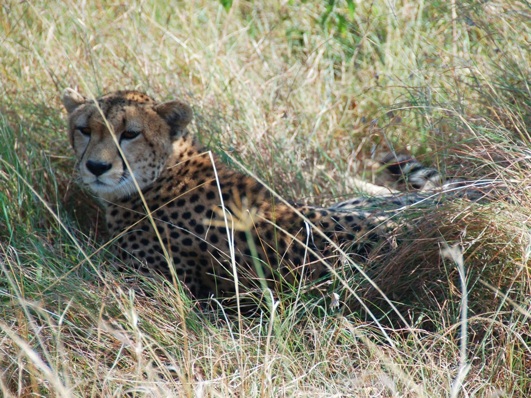Fact: Lions and hyenas aren't the only animals cheetahs have to be concerned about. Cheetah movement can attract vultures, and these birds sometimes force a hungry cheetah from its rightly earned kill. When vultures descend on a carcass, it attracts other carnivores that food is available, and then even the vultures have competition. To lessen the likelihood of this situation from ever happening, cheetahs use their stealth so they won't attract attention when they're hunting. Cheetahs will also drag their kill to a hiding place, so they can eat without those pesky vultures watching. Hey, they're not called vultures for nothing!
Source: All the World's Animals: Carnivores, by George W. Frame, page 33.
Fact: Cheetahs are unique from other cats, in that their claws have no protective covering. Cheetahs can only partly retract their claws, and because of this, the claws become blunted and give them better traction for speed -- similar to a sprinter wearing cleats.
Source: National Geographic Book of Mammals, Volume One, prepared by the Special Publications Division, page 143.
Take a wild guess! A cheetah's running stride is so fast, only one foot touches the ground at a time. At two points in the stride, how many feet touch the ground?
Three. The cheetah needs to touch three feet to the ground at a time, to propel it forward so fast.
Two. This is a trick question, so I'm playing it safe.
None. Hey, this IS the cheetah we're talking about!
Answer: None. The cheetah's elastic spine enables it to run so efficiently, at two points in its stride, the cheetah isn't touching the ground at all. This animal is built for speed!
Source: Cheetah Outreach.

Image Source: The Dilly Lama / License under Creative Commons 2.0.
Available in two sizes:
1024 x 768 || 800 x 600
Fact: Cheetahs can't run indefinitely, and in fact, tire quickly. They can only maintain full speed for about 300 yards (274m), and are better suited to short bursts of speed rather than long marathons. Even so, 300 yards isn't shabby. It's the equivalent of three football fields.
Source: National Geographic Book of Mammals, Volume One, prepared by the Special Publications Division, page 143.
Fact: Like other animals, cheetahs must have water to survive. However, unlike most other animals, cheetahs can survive for long periods of time without drinking water. Instead, they obtain water from the body fluid of their prey. This enables cheetahs to go up to ten days without taking an additional drink of water.
Source: Big Cat Rescue.
Fact: Cheetahs can weigh between 86 to 143 lbs (that's 39 to 65 kg).
Source: All the World's Animals: Carnivores, by George W. Frame, page 31.

Image Source: Snake3yes / License under Creative Commons 2.0.
Available in two sizes:
1024 x 768 || 800 x 600
Fact: Herbivores, like the zebra and antelope, must live where their food source grows; where you find herbivores, you find carnivores like the cheetah. The plant eaters graze, and the meat eaters graze the plant eaters. It's all part of the food chain.
Source: Childcraft, The How and Why Library, Volume 5, page 218.
Fact: Cheetahs don't have the impressive sharp teeth that lions have, and because of this, cheetahs must slowly strangle their prey instead of piercing their victims' throats they way a leopard would. This saves room in the cheetah's skull, making space for the large nasal cavity cheetahs need to reach such high speeds. It's a tradeoff.
Source: The Cheetah Spot.